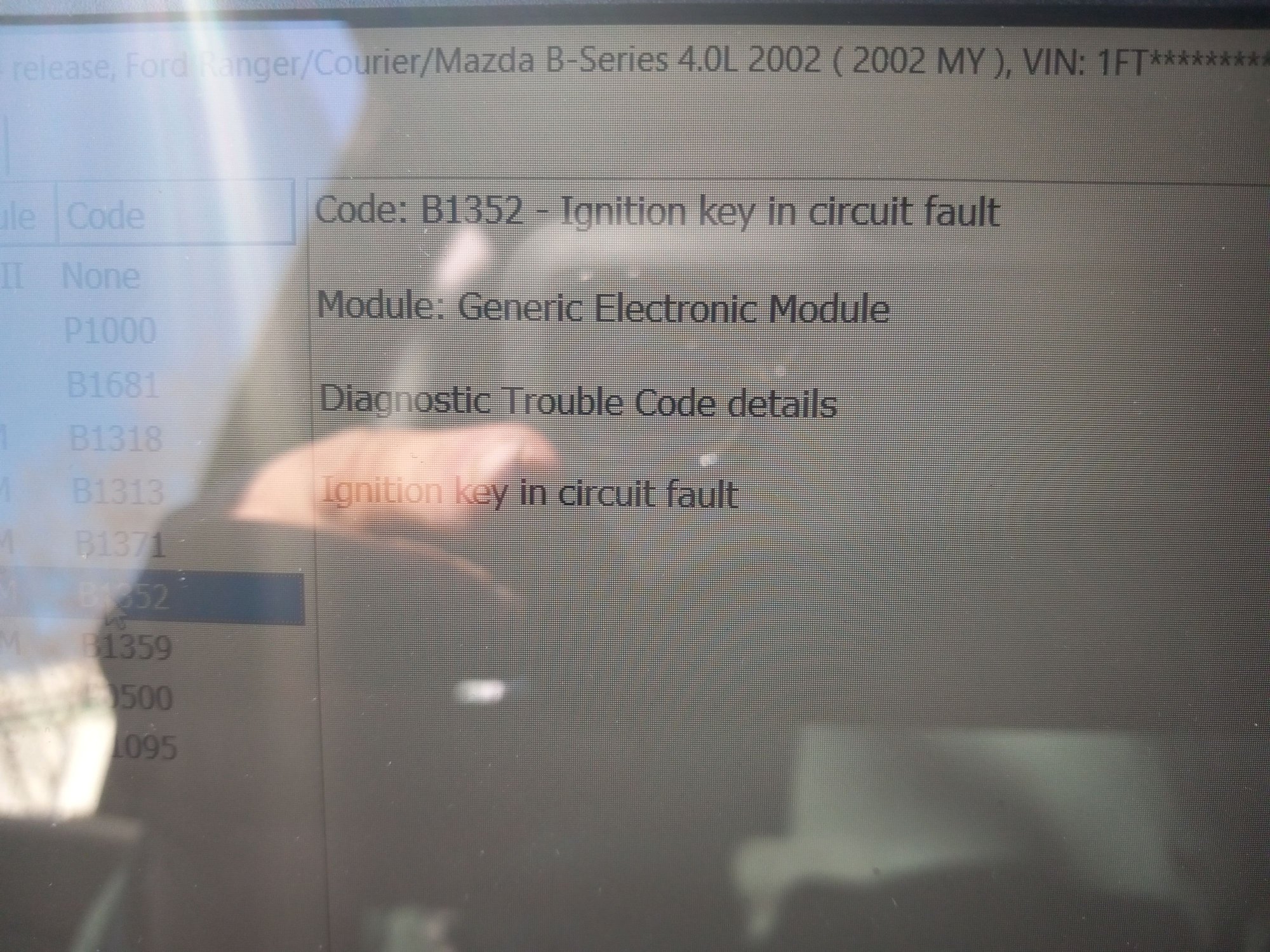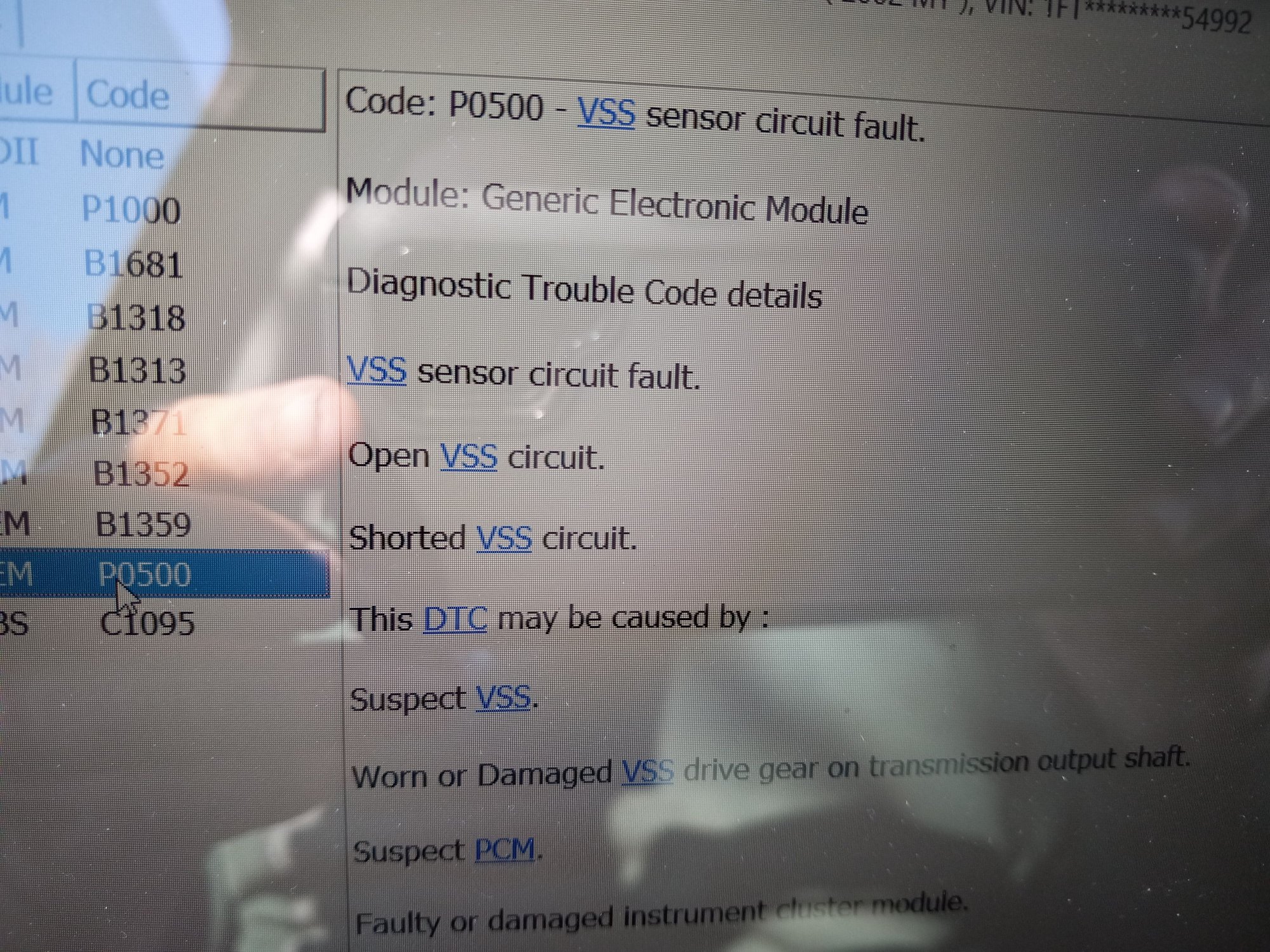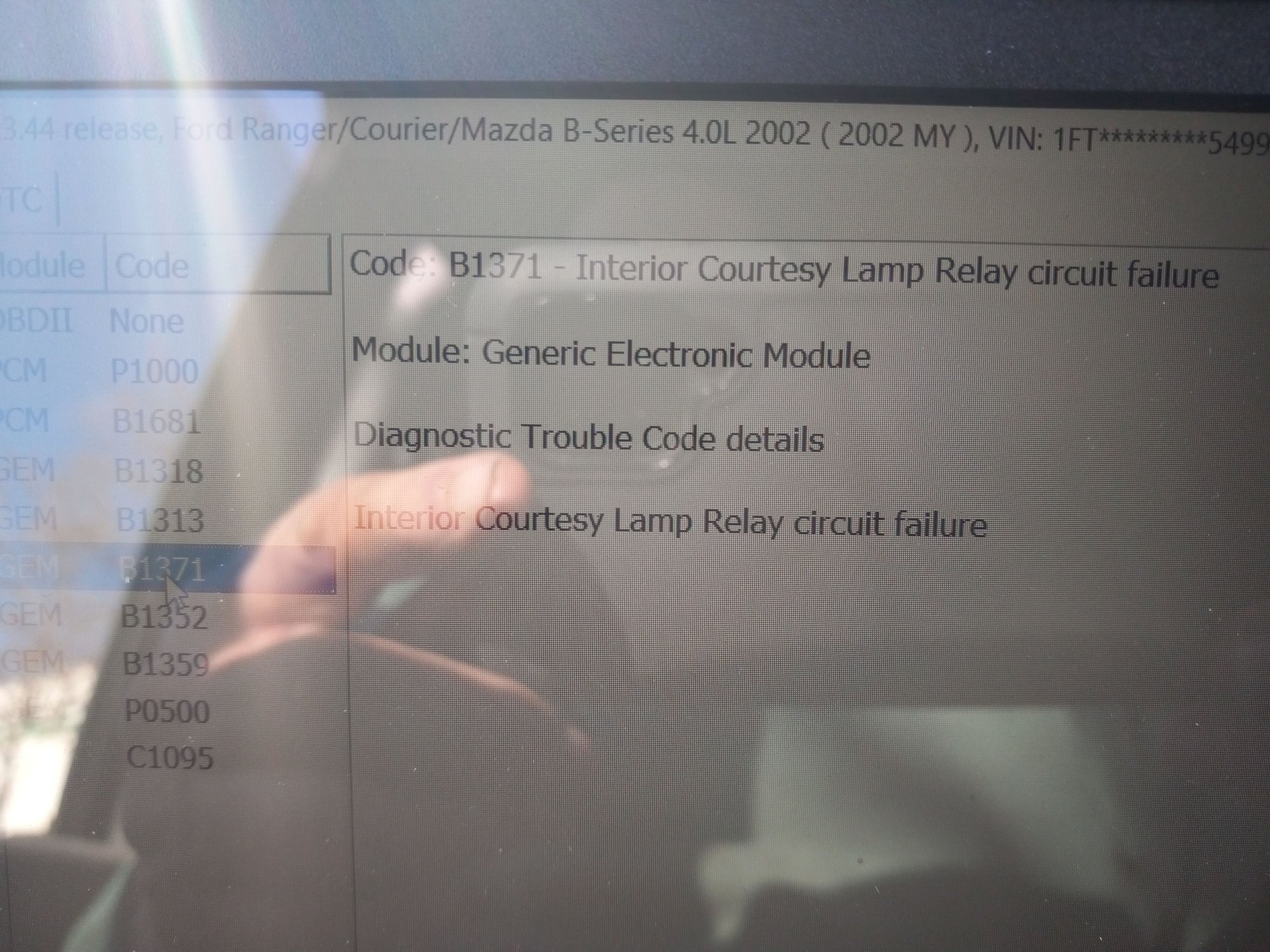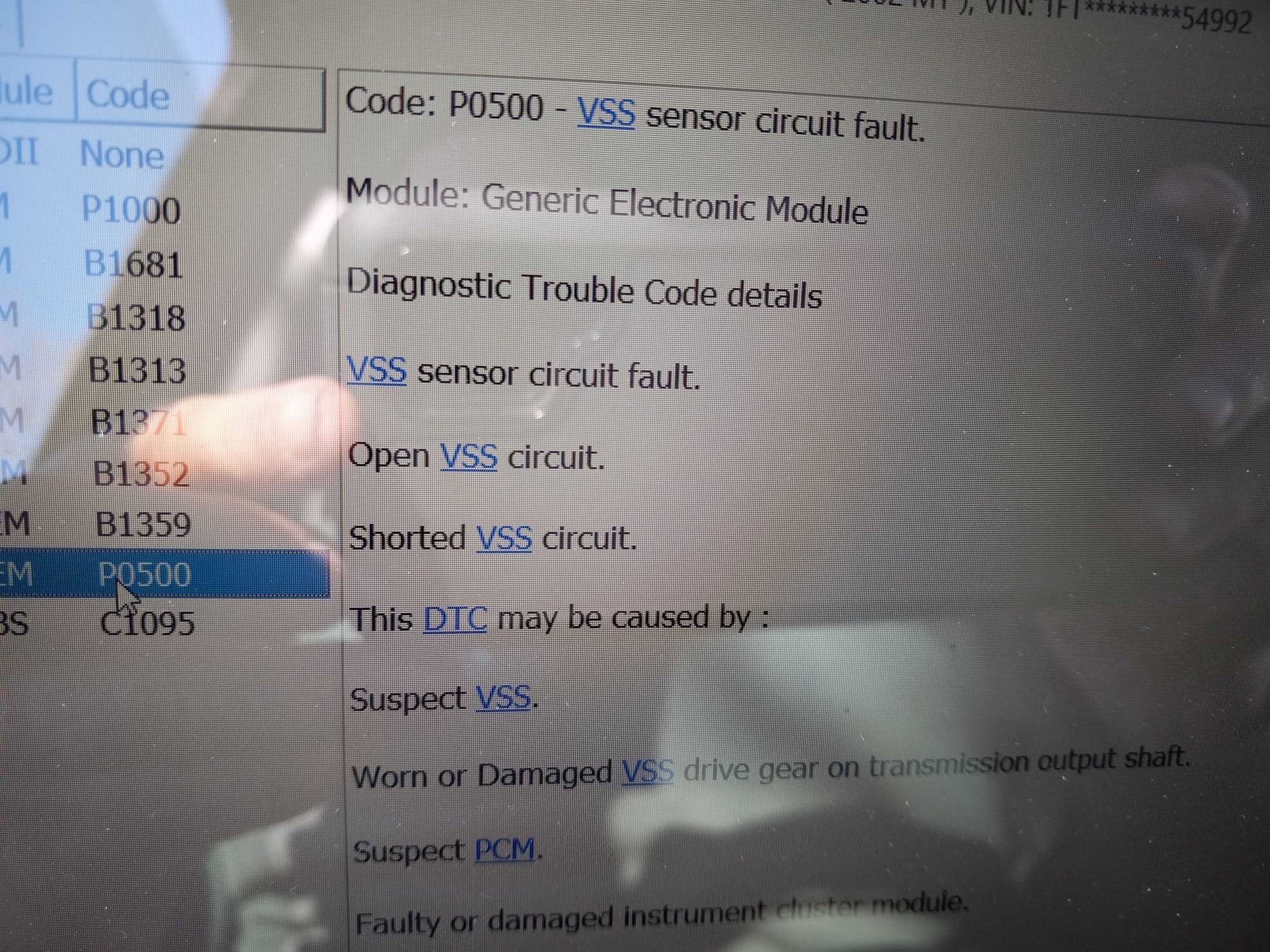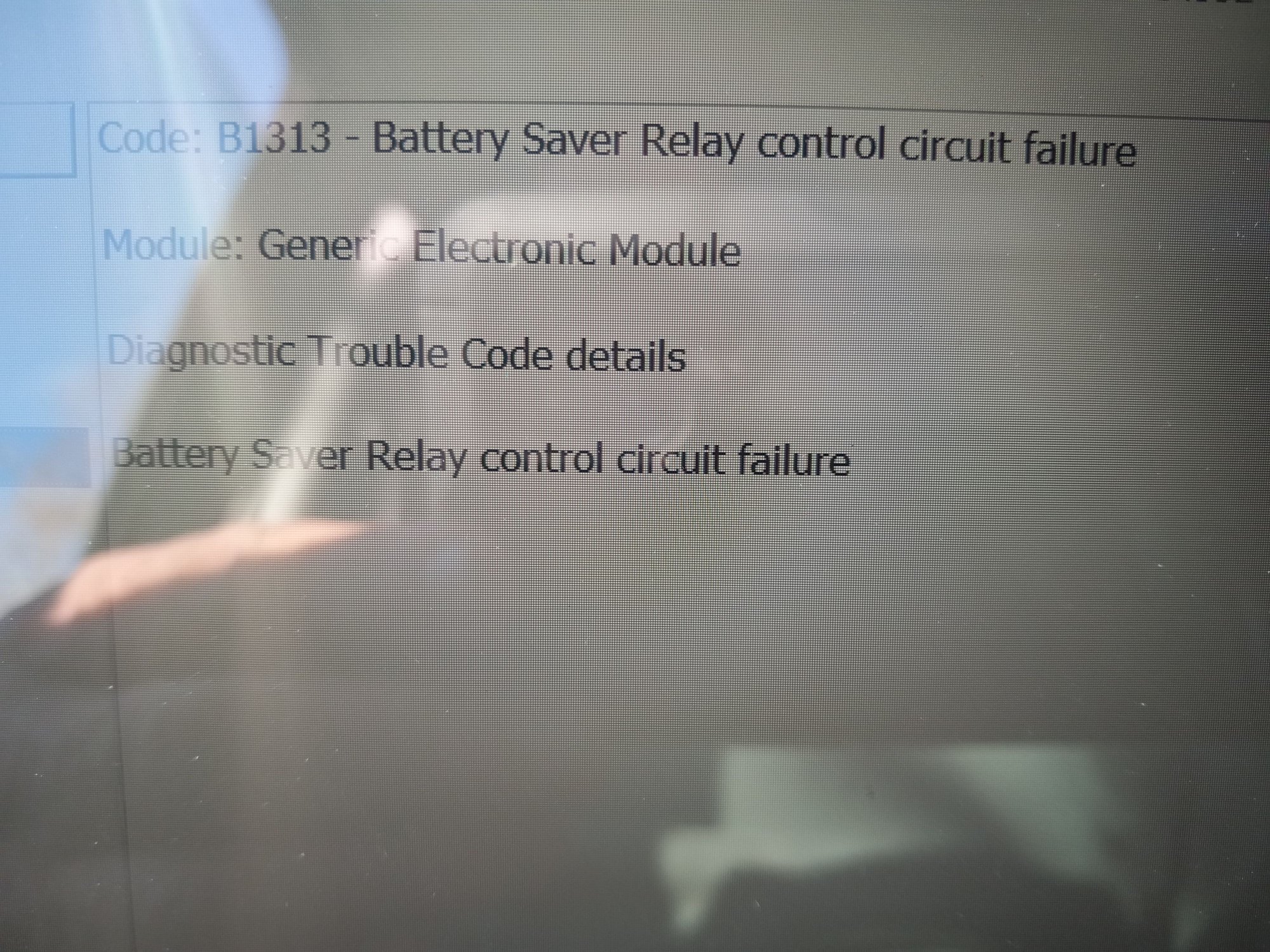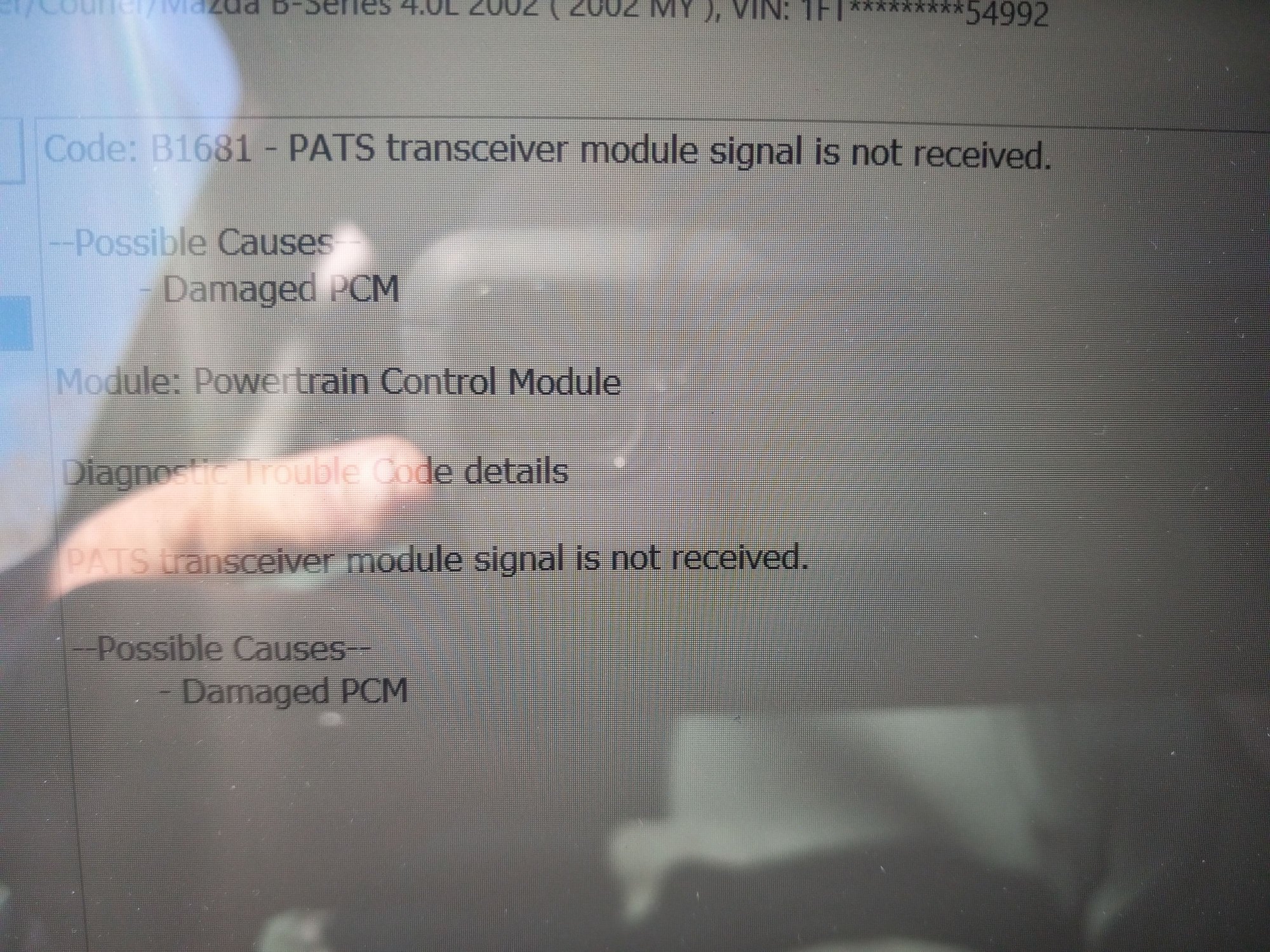Dave P
#1
Dave P
poltergist22
I pull up to the gate at work and shut down my 2002 ford ranger 4.0 I go inside to disarm the gate and come back to my truck and it turns over but won't start, then it quit even turning over, parked it for a week gone on a trip and return and same thing won't even turn over, checked the ignition fuse in the fuse box it's good and getting power, checked the 50 amp.fuse in the power box under the hood it's good, the anti theft is blinking like crazy when it has ON , but blinking every 2 seconds when OFF , the starter is getting no juice, I tried resetting the anti theft with on and off turns of the key but it just continues to blink like crazy and if left on it goes out completely after a couple minutes, ???? Any suggestions?
I pull up to the gate at work and shut down my 2002 ford ranger 4.0 I go inside to disarm the gate and come back to my truck and it turns over but won't start, then it quit even turning over, parked it for a week gone on a trip and return and same thing won't even turn over, checked the ignition fuse in the fuse box it's good and getting power, checked the 50 amp.fuse in the power box under the hood it's good, the anti theft is blinking like crazy when it has ON , but blinking every 2 seconds when OFF , the starter is getting no juice, I tried resetting the anti theft with on and off turns of the key but it just continues to blink like crazy and if left on it goes out completely after a couple minutes, ???? Any suggestions?
#2
Welcome to the forum
Test battery voltage
Needs to be 12.3volts or higher or PATS(anti theft light) will activate when you try to start engine
12.8v is a new battery
12.5v is a 3 year old battery
12.3v is a 5/6 year old battery and time to shop for battery sales
12.2v or less is a DONE battery, replace it
Leave key on and anti theft light will start to flash a 2 digit code number after 45-60 seconds and that will tell you WHY PATS was activated
Theft light will pause and do 1 flash then pause and do 1 to 6 flashes, then longer pause and repeat, codes are 11 to 16, seen here:
11 Transceiver [transponder coil] not connected, or there is no power to it.
12 Transceiver internal fault.
13 No Key/no PATS key has been used to turn the ignition switch.
14 Incomplete key code received.
15 Invalid key code received.
16 CAN communications error.
Outside of low battery voltage(codes 13, 14), the most common issue is failed transceiver
Transceiver is the powered antenna fitted around the key slot, its a ring antenna
Read this thread for changing transceiver: https://www.ranger-forums.com/genera...turned-165716/
At this time PATS is the main issue, no other diagnostics can be done until you get the normal Theft light on and then off with key on, flashing theft light with key on stops any other testing
Test battery voltage
Needs to be 12.3volts or higher or PATS(anti theft light) will activate when you try to start engine
12.8v is a new battery
12.5v is a 3 year old battery
12.3v is a 5/6 year old battery and time to shop for battery sales
12.2v or less is a DONE battery, replace it
Leave key on and anti theft light will start to flash a 2 digit code number after 45-60 seconds and that will tell you WHY PATS was activated
Theft light will pause and do 1 flash then pause and do 1 to 6 flashes, then longer pause and repeat, codes are 11 to 16, seen here:
11 Transceiver [transponder coil] not connected, or there is no power to it.
12 Transceiver internal fault.
13 No Key/no PATS key has been used to turn the ignition switch.
14 Incomplete key code received.
15 Invalid key code received.
16 CAN communications error.
Outside of low battery voltage(codes 13, 14), the most common issue is failed transceiver
Transceiver is the powered antenna fitted around the key slot, its a ring antenna
Read this thread for changing transceiver: https://www.ranger-forums.com/genera...turned-165716/
At this time PATS is the main issue, no other diagnostics can be done until you get the normal Theft light on and then off with key on, flashing theft light with key on stops any other testing
#3
Welcome to the forum
Test battery voltage
Needs to be 12.3volts or higher or PATS(anti theft light) will activate when you try to start engine
12.8v is a new battery
12.5v is a 3 year old battery
12.3v is a 5/6 year old battery and time to shop for battery sales
12.2v or less is a DONE battery, replace it
Leave key on and anti theft light will start to flash a 2 digit code number after 45-60 seconds and that will tell you WHY PATS was activated
Theft light will pause and do 1 flash then pause and do 1 to 6 flashes, then longer pause and repeat, codes are 11 to 16, seen here:
11 Transceiver [transponder coil] not connected, or there is no power to it.
12 Transceiver internal fault.
13 No Key/no PATS key has been used to turn the ignition switch.
14 Incomplete key code received.
15 Invalid key code received.
16 CAN communications error.
Outside of low battery voltage(codes 13, 14), the most common issue is failed transceiver
Transceiver is the powered antenna fitted around the key slot, its a ring antenna
Read this thread for changing transceiver: https://www.ranger-forums.com/genera...turned-165716/
At this time PATS is the main issue, no other diagnostics can be done until you get the normal Theft light on and then off with key on, flashing theft light with key on stops any other testing
Test battery voltage
Needs to be 12.3volts or higher or PATS(anti theft light) will activate when you try to start engine
12.8v is a new battery
12.5v is a 3 year old battery
12.3v is a 5/6 year old battery and time to shop for battery sales
12.2v or less is a DONE battery, replace it
Leave key on and anti theft light will start to flash a 2 digit code number after 45-60 seconds and that will tell you WHY PATS was activated
Theft light will pause and do 1 flash then pause and do 1 to 6 flashes, then longer pause and repeat, codes are 11 to 16, seen here:
11 Transceiver [transponder coil] not connected, or there is no power to it.
12 Transceiver internal fault.
13 No Key/no PATS key has been used to turn the ignition switch.
14 Incomplete key code received.
15 Invalid key code received.
16 CAN communications error.
Outside of low battery voltage(codes 13, 14), the most common issue is failed transceiver
Transceiver is the powered antenna fitted around the key slot, its a ring antenna
Read this thread for changing transceiver: https://www.ranger-forums.com/genera...turned-165716/
At this time PATS is the main issue, no other diagnostics can be done until you get the normal Theft light on and then off with key on, flashing theft light with key on stops any other testing
#5
It seems to be 11 again , it blinks fast then blink about 2 seconds a blink again
I read after trying 4 times it will lock out for 90 minutes? So waiting now for 90 minutes
I read after trying 4 times it will lock out for 90 minutes? So waiting now for 90 minutes
Last edited by poltergist22; 07-15-2021 at 02:19 PM. Reason: Mo
#6
Positive or negative battery cable to starter motor/engine are not able to carry enough amps
That caused the "clicking", classic symptom of starter motor not getting enough amps, either because battery is Kaput, or cables are
And that caused the PATS reset
12.6volt is good if battery was tested after sitting for over 6 hours, if it was just recharged then could be battery is old
Never use a running engine and jumper cables on any vehicle made after 1990
You can use jumper cables from a another battery but have the other car SHUT OFF no key in it at all
You can fry BOTH vehicles electrical systems
Transceiver from wrecking yard is a roll of the dice, as you know, but they didn't break that often...........so not a bad bet, but still..................same code
That caused the "clicking", classic symptom of starter motor not getting enough amps, either because battery is Kaput, or cables are
And that caused the PATS reset
12.6volt is good if battery was tested after sitting for over 6 hours, if it was just recharged then could be battery is old
Never use a running engine and jumper cables on any vehicle made after 1990
You can use jumper cables from a another battery but have the other car SHUT OFF no key in it at all
You can fry BOTH vehicles electrical systems
Transceiver from wrecking yard is a roll of the dice, as you know, but they didn't break that often...........so not a bad bet, but still..................same code
#7
#9
You CAN jump newer vehicles and all will be OK, until the one time it isn't, lol
And electrics in jump vehicle or jumping vehicle can be effected
Its a roll of the dice, so just don't have the jumping vehicle running and have its key OFF when using its battery
If starter motor won't turn with 600+ CCA(cold cranking amps) of two battery's then something ELSE is wrong
General rule of thumb is that you need 1 CCA per cubic inch of engine displacement, 4.0l is 245 cubic inch, so 245 CCA for battery rating, most car/truck batteries are 550-650CCA
(Diesels needs 2 CCA per cubic inch)
Starter motor draws 50-75amps so battery cables need to be BIG, and clean, and JUMPER CABLES need to pass that same 50-75amps so starter can draw and send back that higher amp flow
DC systems requires TWO WAY flow
75 amps OUT to starter motor
75 amps BACK to Battery Negative
If dirty or bad Negative can only pass 25 amps then Positive can only send 25amps, just physics, but a hard and fast reality
And electrics in jump vehicle or jumping vehicle can be effected
Its a roll of the dice, so just don't have the jumping vehicle running and have its key OFF when using its battery
If starter motor won't turn with 600+ CCA(cold cranking amps) of two battery's then something ELSE is wrong
General rule of thumb is that you need 1 CCA per cubic inch of engine displacement, 4.0l is 245 cubic inch, so 245 CCA for battery rating, most car/truck batteries are 550-650CCA
(Diesels needs 2 CCA per cubic inch)
Starter motor draws 50-75amps so battery cables need to be BIG, and clean, and JUMPER CABLES need to pass that same 50-75amps so starter can draw and send back that higher amp flow
DC systems requires TWO WAY flow
75 amps OUT to starter motor
75 amps BACK to Battery Negative
If dirty or bad Negative can only pass 25 amps then Positive can only send 25amps, just physics, but a hard and fast reality
#11
#12
Still patiently sitting
I can't find wiring diagrams as to where the 4 wire plug goes to, it still blinks 11, I checked another ranger site the guy says he went thru all this himself bought forscan software and then he read something that said if the check engine light stays on while the anti theft is rapidly blinking it isn't the PATS system??? I don't want to send a mobile locksmith here if it isn't the key, any suggestions or a diagram so I can check the complete system step by step?
#13
Not true about the CEL, that's computer(PCM) not PATS system, but CEL will not turn off since engine won't crank in any case
CEL come on with key on and will stay on until engine is turning and PCM gets a timing signal from crank sensor
Picture of transceiver installed: https://www.ranger-forums.com/attach...n-img_5225.jpg
The BLACK covered wire harness is the 4 transceiver wires not the yellow
Picture of transceiver 4 wire plug-in, to the right of steering column behind dash cover: https://www.ranger-forums.com/attach...n-img_5226.jpg
The WHITE connector, not the brown or red
Can also be a Grey connector on some years
CEL come on with key on and will stay on until engine is turning and PCM gets a timing signal from crank sensor
Picture of transceiver installed: https://www.ranger-forums.com/attach...n-img_5225.jpg
The BLACK covered wire harness is the 4 transceiver wires not the yellow
Picture of transceiver 4 wire plug-in, to the right of steering column behind dash cover: https://www.ranger-forums.com/attach...n-img_5226.jpg
The WHITE connector, not the brown or red
Can also be a Grey connector on some years
Last edited by RonD; 12-26-2021 at 03:04 PM.
#14
So I unplugged the pcm and put a volt meter into each of the 4 plug wires to check for continuity, (sp) theres a red wire that has continunity to 13 of the pcm plugs pins, a green wire that has continunity to 14 of the pcm pins a white wire that has continunity to only one pin and a blue wire that has continunity to only 1 pin. However the multimeter would quickly chirp but not give a reading on 4 of the blue wires pins ? I used Forscan and it has dtc's, stating no connection for PATS, and a battery saver relay, dome light and ABS malfunction, where to go from here? I think I need a chart showing what these continunity connections lead to but I find pin out charts that don't say : example say pin 38 has continunity to the 4way pin what is pin 38 in the pcm? And why these quick chirps, on some of the pins with the blue wire?
#15
Not sure what connector you are testing?
best to get a 2002 Ford Ranger Wiring Diagram manual, like this one: https://www.ebay.com/itm/254351847168
It covers all 2002 Ranger models, and all options
Ford sends these out every year for every model to all Ford Dealer shops so they can troubleshoot
These are always in demand so you can sell it after using it
Diagram for 2002 PATS wiring below
best to get a 2002 Ford Ranger Wiring Diagram manual, like this one: https://www.ebay.com/itm/254351847168
It covers all 2002 Ranger models, and all options
Ford sends these out every year for every model to all Ford Dealer shops so they can troubleshoot
These are always in demand so you can sell it after using it
Diagram for 2002 PATS wiring below
#20
Im wondering why I have continunity to all these other wires? I unplugged the pcm and put the negative lead in each hole of the plug individually while I had the positive lead hooked to each individual wire of the transponder and it had continunity in as many of the wires as I mentioned earlier, of course the battery was disconnected
#21
Not sure how you are testing this?
Unplug the transceiver, it has "continuity" on all 4 wires
Set meter to OHMs
You are testing the trucks 4 wire connector not transceiver
Ground one probe to dash metal bolt, test Black wire with other probe, should see 0 ohms, a good ground
Test the other 3 if you want, should see no change or high ohms
Hook battery back up
turn on the key
Set meter to DC Volts
Put black probe on same metal bolt
Test red wire with red probe, should see 12volts, if not check fuse 19
If you have a good ground and 12v key on then those wires are good
Continuity is a different ballgame with vehicle wiring because all wires SHOULD BE connected at some point to each other, that's how they work, i.e. there is continuity between Battery Positive and Negative because powered devices need BOTH internally to work
Switch meter over to OHMs and do your test, it you see ANY ohms then that would test "positive" in continuity test
You can test individual wires by using a long wire that you know is good(test its continuity) with a continuity test
Hook the long wire to the far end of the wire you want to test
Switch meter to continuity
Put the probes on long wire end and the wire you want to test
Should have good continuity
You can also switch meter to OHMs and test should be 0 ohms or under 5ohms
This means wire is OK
Unplug the transceiver, it has "continuity" on all 4 wires
Set meter to OHMs
You are testing the trucks 4 wire connector not transceiver
Ground one probe to dash metal bolt, test Black wire with other probe, should see 0 ohms, a good ground
Test the other 3 if you want, should see no change or high ohms
Hook battery back up
turn on the key
Set meter to DC Volts
Put black probe on same metal bolt
Test red wire with red probe, should see 12volts, if not check fuse 19
If you have a good ground and 12v key on then those wires are good
Continuity is a different ballgame with vehicle wiring because all wires SHOULD BE connected at some point to each other, that's how they work, i.e. there is continuity between Battery Positive and Negative because powered devices need BOTH internally to work
Switch meter over to OHMs and do your test, it you see ANY ohms then that would test "positive" in continuity test
You can test individual wires by using a long wire that you know is good(test its continuity) with a continuity test
Hook the long wire to the far end of the wire you want to test
Switch meter to continuity
Put the probes on long wire end and the wire you want to test
Should have good continuity
You can also switch meter to OHMs and test should be 0 ohms or under 5ohms
This means wire is OK
#22
I have a red and green wire a black and white wire a orange and green wire and a brown and tan wire at this connection the red and green reads 14.9,the black and white read 1.4 the other 2 no reading but I do get a chirp from the orange one thats battery disconnected. Connected im reading 11 volts out of the red one and 12 volts out of the orange one?
#23
Red/green should be 12v engine off key on
Black/white is a ground
Put red meter probe on red/green wire
Put black meter probe on Black/white wire
With key on/engine off you should see Battery voltage, 12.3v to 12.8v
If not Ground wire(black/white) is bad
The other 2 wires run to the Computer, pins 17 and 18, they can be tested by disconnecting Computer's 104 wire connector and test each wire using a long jumper wire
If both wires test as OK then replace transceiver, cheapest option for now
If that doesn't solve the problem then you will be replacing the Computer, and need to have PATS reprogrammed for your current keys
Black/white is a ground
Put red meter probe on red/green wire
Put black meter probe on Black/white wire
With key on/engine off you should see Battery voltage, 12.3v to 12.8v
If not Ground wire(black/white) is bad
The other 2 wires run to the Computer, pins 17 and 18, they can be tested by disconnecting Computer's 104 wire connector and test each wire using a long jumper wire
If both wires test as OK then replace transceiver, cheapest option for now
If that doesn't solve the problem then you will be replacing the Computer, and need to have PATS reprogrammed for your current keys
#24
I got 12.5 for the first test, I think your saying to just test for continuity on the second test and it was good, just to make sure I also tested 17 and 18 for volts and there was nothing, I've already replaced the transceiver so I guess its new computer time, is this normal for it to just go all at once? I have to thank you for your help I'm very limited time wise and you have helped tremendously. THANK YOU
#25
There would be no "volts" for computer pins 17 and 18, its an antenna termination
The transceiver is a "powered" antenna
Power is the 12v and ground, 2 wires
The other two wires are used for the same function as the 2 wires than come in from your Radio's antenna, 2 wires in the form of a Coaxial(round) cable, center and outer wire
So 17 and 18 have no "voltage" but do pass a signal from transceiver to computer when PATS is activated with key on, like your Radio receives a signal from near by radio broadcasting towers
The antenna in the transceiver picks up the wireless broadcast from the PATS key, 17 and 18 are the continuation of the "antenna's"(coil's) 2 wires, like the wire that comes in from passenger side radio antenna to the back of the radio in the cab
No "voltage", just a signal
PATS code 11 Transceiver [transponder coil] not connected, or there is no power to it.
If new transceiver looks to be in good condition, then yes computer may be the issue
You would test the pin 17 and 18 wires with continuity or ohm meter, need a long jumper wire to do this
The transceiver is a "powered" antenna
Power is the 12v and ground, 2 wires
The other two wires are used for the same function as the 2 wires than come in from your Radio's antenna, 2 wires in the form of a Coaxial(round) cable, center and outer wire
So 17 and 18 have no "voltage" but do pass a signal from transceiver to computer when PATS is activated with key on, like your Radio receives a signal from near by radio broadcasting towers
The antenna in the transceiver picks up the wireless broadcast from the PATS key, 17 and 18 are the continuation of the "antenna's"(coil's) 2 wires, like the wire that comes in from passenger side radio antenna to the back of the radio in the cab
No "voltage", just a signal
PATS code 11 Transceiver [transponder coil] not connected, or there is no power to it.
If new transceiver looks to be in good condition, then yes computer may be the issue
You would test the pin 17 and 18 wires with continuity or ohm meter, need a long jumper wire to do this





